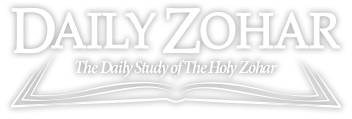Daily Zohar # 4295 – Shelach Lecha – The King’s daughter and that day
Daily Zohar 4295

Hebrew translation:
257. עֲתִידָה יְרוּשָׁלַיִם לְהוֹצִיא מַיִם וְלִנְבֹּעַ מַבּוּעַ. כָּאן יֵשׁ לוֹמַר, סוֹף לְכָל הַדְּרָגוֹת אֵינָהּ יְרוּשָׁלַיִם, אֶלָּא וַדַּאי יְרוּשָׁלַיִם וְיוֹם הַהוּא, הַכֹּל אֶחָד. מַה בֵּין זֶה לָזֶה? אֶלָּא יְרוּשָׁלַיִם, כָּל הַדְּרָגוֹת הַקְּדוֹשׁוֹת שֶׁלָּהּ, כְּשֶׁסּוֹבְבִים נִקְרָאִים יְרוּשָׁלַיִם, וְכָךְ נִרְאִים. וְיֵשׁ דְּרָגוֹת שֶׁסּוֹבְבוֹת, וְנִקְרָאוֹת עֲזָרוֹת. אֵלֶּה פְּנִימִיּוֹת וְאֵלֶּה בַּחוּץ. וְיֵשׁ דְּרָגוֹת שֶׁנִּקְרָאוֹת כְּשֶׁסּוֹבְבוֹת לְשָׁכוֹת. (כְּשֶׁמִּסְתּוֹבְבוֹת אֵלּוּ הַפְּנִימִיּוֹת וְאֵלּוּ לְבַחוּץ, נִקְרְאוּ יְרוּשָׁלַיִם. וְיֵשׁ דְּרָגוֹת שֶׁסּוֹבְבוֹת, וְנִקְרָאוֹת עֲזָרוֹת. וְיֵשׁ דְּרָגוֹת שֶׁנִּקְרָאוֹת לְשָׁכוֹת) וְיֵשׁ דְּרָגוֹת שֶׁנִּקְרָאוֹת כְּשֶׁסּוֹבְבוֹת הֵיכָל וּדְבִיר. לִפְנִים מִכָּל אֵלּוּ הַדְּרָגוֹת יֵשׁ נְקֻדָּה אַחַת, (תהלים מה) כְּבוּדָּה בַת מֶלֶךְ פְּנִימָה. נְקֻדָּה זוֹ נִקְרֵאת יוֹם הַהוּא, וְסִימָנְךָ – (דברים ג) הַהוּא יִקָּרֵא אֶרֶץ.
.
Zohar Shelach Lecha
Continued from previous DZ
#256
The child opens and quotes, “וְהָיָה בַּיּוֹם הַהוּא” “And in that day it shall be” (#252). He asked what day is “ביום ההוא” “That day.” He answers, everywhere “ההוא” “that day” is mentioned, it is the last day. Why is it called “that day”? Because it is a day that its end connects to its beginning, which is Binah that is called “הוא” “That” as it is written in Numbers 18:23 “וְעָבַד הַלֵּוִי הוּא אֶת עֲבֹדַת אֹהֶל מוֹעֵד” “But the Levites shall perform the work of the tabernacle of meeting.” The service of the Levites is to the level of Binah, which is called “הוא” “He (That).” It is a hidden level, as the word “הוא” “He (That)” implied. When the word comes with the letter “ה” at the beginning as “ההוא,” it refers to Malchut, which is the last of the sefirot but connected to the head that is Binah.
#257
In the future, Jerusalem would become a spring of flowing water. Jerusalem at the end of all levels and with “יום ההוא” “that day,” they are one, and both are Malchut. What is the difference between each other? The difference is that Jerusalem, when all its holy levels surround her, is called Jerusalem. The levels that surround her are called “עזרות” Azarot (Service areas), some are internal, and some surround her from the outside. Some levels are more internal, which are called office chambers. And some levels are called, when they surround her, “היכל” and “דביר,” “Palace,” and “Sanctuary.”
In front of all these levels, there is one point called “King’s daughter”;
Psalm 45:14
“כָּל כְּבוּדָּה בַת מֶלֶךְ פְּנִימָה מִמִּשְׁבְּצוֹת זָהָב לְבוּשָׁהּ.”
“The royal daughter is all glorious within the palace; Her clothing is woven with gold.”
This point is called “מנעולא” the “hidden lock” that is where the judgments in Machut are concealed. This point is also called “ יום ההוא,” “That day.”
{||}

 Previous: Shelach Lecha
Previous: Shelach Lecha
